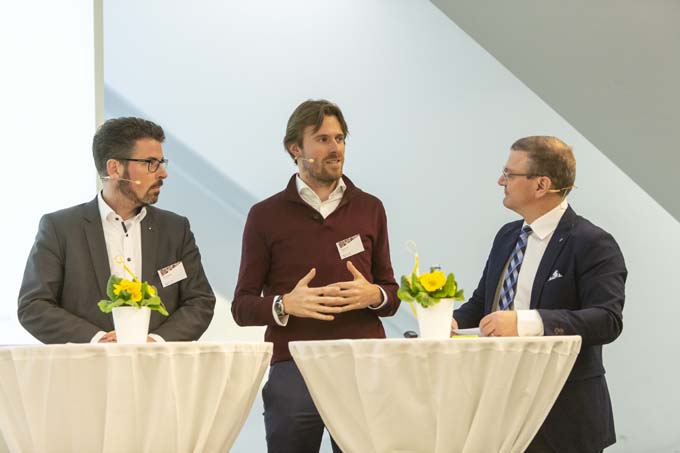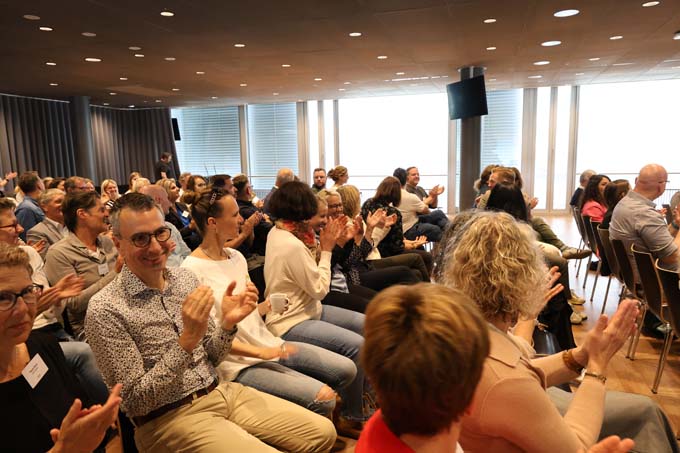Unternehmensspiegel Ostschweiz: Making mice with digital mousetraps
Digitalization is giving rise to new business concepts, i.e. what services a company wants to offer, how and for whom and with whom. The regional examples presented at the 10th Unternehmensspiegel Ostschweiz of the FHS St.Gallen - digital mousetraps, personalized advertisements or blockchain real estate investments - proved in what different ways and, above all, how successful one can make mice with digital technologies.

One would like to assume that the term "digitalization" has actually already passed the zenith of hype. However, the 10th Unternehmensspiegel Ostschweiz, held on March 13, 2019 at the Pfalzkeller in St.Gallen, showed that digitalization will not be a change process that is ever completed. Digitization can also be understood as an umbrella term for new tools or to put it as a comparison: Digitization is the machine, and while it used to be powered by steam, innovations have led to fuel or electric drives that generate energy from diesel or the sun. Even if the machines have changed, they are still present and the process of change of the machines will probably never really be over.
Networked mousetraps
The new tools that are available, which in turn mean new ways of working or new business and customer benefits, were demonstrated by Prof. Dr. Rigo Tietz, Head of the Competence Center Strategy & Management at the Institute for Corporate Management at the University of Applied Sciences St.Gallen (IFU-FHS), using a variety of local examples: Among them were Parametric's mousetraps: companies in the food industry have strict hygiene regulations. At the same time, animal welfare regulations specify how mice must be caught and how long they may remain in the trap. Parametric's mousetraps are an Internet of Things product that detects when a mouse has been caught and only requests processing for those traps with confirmed catches. This eliminates a potentially significant number of labor hours: Even with only 3 minutes of work per mouse trap, an annual effort of several hundred hours of work time and several thousand francs of costs is incurred for 10 traps.
Something additional to something existing
In the 2017 SME Mirror of the IFU-FHS, 43% of the respondents identified digitization as an opportunity in the development and implementation of new business concepts. This is often something additional to something existing: There is a product (car) that is networked (the car can be rented via an Internet solution). The data generated through use enables optimization (the car transmits travel routes, which can be used to anticipate how many cars are needed where), and finally a business concept is enabled that is integrated into a smart, connected ecosystem (the card used to unlock the cars can also store tickets or ski tickets). This cascade shows the opportunities inherent in a digital business concept (data evaluation, mediation of supply and demand), although Rigo Tietz listed others, such as the fact that digital technologies can reduce activities and routine tasks and thus save effort and costs.

Advertising space "customized
While data security is probably not yet an issue with the aforementioned mousetraps, the monitoring of travel routes or the example of Advertima showed that there is also something unpleasant about digitization: Using visual sensors, the product looks at people in a shopping mall, for example, recognizes the person's gender and age by means of an algorithm, and displays suitable offers for this person on the advertising spaces the person walks past. The software can then "track" the person, e.g. to check whether the person subsequently asks for a displayed offer in the advertised store. For reassurance, the very strict Swiss data protection law can be mentioned here, which ensures that the individual data is deleted again immediately and only summarized "metadata" is kept and shared with the customers.
Blockchain in the real estate business
The strict Swiss regulations were also a topic in the panel discussion led by Prof. Dr. Roland Waibel, Head of IFU-FHS, between Dr. Michael Steiner, Chairman of the Executive Board of Acrevis Bank AG, St.Gallen and Domenic Kurt, CEO of Crowdli and Crowdlitoken AG, Frauenfeld, the latter company enabling investments in real estate using blockchain technology. Acrevis is investing 20 million in digitalization and automation, prioritizing the "customer interface" rather than processes: It wants to provide customers with as much freedom as possible in managing their banking transactions. As Michael Steiner explains, while it is to be expected that the longer these options are available, the more customers will demand them, what is generally the case with digitization projects is that you don't know when the time is right; when a technology will catch on. And if you are too early or too late, it hurts the company. The second issue that triggers uncertainty is that you don't know which technological solutions will prevail and survive in the long term.
Another Unternehmensspiegel Ostschweiz will take place on March 26 in Teufen, Appenzell. Source: www.fhsg.ch









